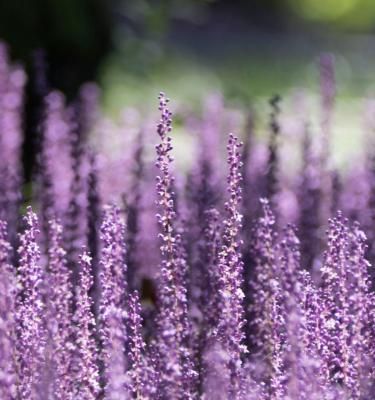
15 Shade Loving Plants That’ll Brighten Up Your Garden
All gardens have their tricky spots, whether too dry, too hot, too shady, or too damp. Shady areas can be due to buildings casting shadows, being north-facing, or established trees.
But, gardeners shouldn’t be put off by the challenges shade throws at us, there is quite a selection of plants that grow well in shade and provide soft lush foliage coupled with blooms and perfume The coolness of a well-planted shady garden corner is also wonderfully refreshing after a busy hot day.
See the list below for the Best Shade Loving Plants for your garden
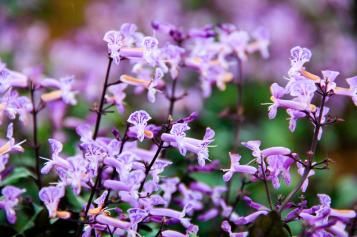
Mona Lavender
Mona Lavender is an easy to care for, perennial and low-growing shrub that enjoys partially shaded conditions. To thrive outside it needs slightly acidic, moist and well-drained soil. Interestingly, Mona Lavender falls into the group of plants whose flowers appear as the days get shorter and the flowers are a more intense purple with indirect bright light.
Use a liquid fertiliser in early spring for maximum blooms. After flowering, the plant can be given a light prune and tidy up, but due to its slow-growing nature, not much pruning is required. With its spires of purple flowers and intricate foliage, Mona Lavender works as well in well-drained pots as in a shady border.

Sweet Box
Sweet Box is an easy no-fuss, compact evergreen shrub that can happily thrive in partial shade through to full shade in Australia. With arching stems and small, glossy leaves, anyone who has a Sweet Box in their garden is rewarded with highly fragrant tiny white flowers in Autumn.
If needed, give it a light prune after flowering, and if a neater shape is preferred, straggling stems can be taken back as well.
There are eleven varieties in the Scarcococca family which are slow growing, making them ideal for even a small garden or walkway where access is needed. If used to edge a path, they will provide a beautiful scent as you brush past them when in flower.
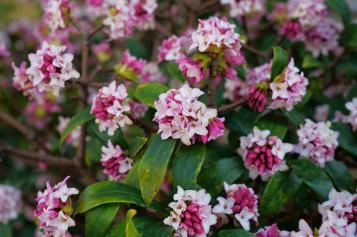
Winter Daphne
The scent of Winter Daphne when in full flower is incredible and it's well worth planting near a doorway you walk by. Its clusters of pink and white flowers appear in the winter through to early spring. Daphne is a slow-growing evergreen shrub that once planted and settled doesn’t like to be moved.
Daphnes have a reputation for being fussy, but to get the best chance of flowers, water sparingly and allow the soil to dry out before watering again. Feed with a controlled-release fertiliser for acid-loving plants after flowering, and due to its slow-growing nature pruning is minimal, if needed at all. When you’re mulching your garden, don’t forget to mulch around your Daphne to keep the roots cool.
When a Winter Daphne is happy, you’ll be rewarded with amazing scented flowers which feels like an added bonus at a duller part of the gardening year. A truly perfumed shade-loving plant.

Spotted Dead Nettle
Lamiums are commonly called Spotted Dead Nettle as they resemble the stinging nettle which deters them from being eaten. However, they have no sting. They are known for their tolerance of dappled shade, full shade, and partial shade making them a great plant for Aussie gardens.
Low-growing and often used for ground cover, it is a member of the lavender and sage family. With mid-green soft leaves that darken at the crown, Dead Nettles’ classic lilac-pink flowers arrive in early Summer. There are however other varieties with variegated silver and green foliage and pink, red or white flowers.
Like many perennials, regular deadheading after flowering will encourage a second flush of flowers. To promote healthy growth just apply an all-purpose liquid fertiliser during its growing season. If your Dead Nettle is getting too large, dividing is best done just before or just after its growing season.
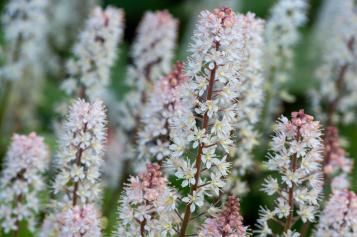
Foamflower
A small compact shade-loving plant that is cold-hardy and flowers in early spring. Its frothy multi-stemmed white flowers are at their best in part or full shade. The Foamflower enjoys well-drained soils and, particularly in winter, not too much water.
Foamflowers work just as well as a shade-loving pot plant, but as they don’t like to be too hot, keep them off patios and other hard landscaping and place pots on feet or as underplanting for larger shrubs or trees. Top up their potting mix regularly as they enjoy a rich soil.
They are a low-maintenance deciduous perennial that needs little pruning with just dead leaves and finished flowers taken off. Classically with white flowers, it is also available in pinks with such names as Raspberry, Sugar and Spice and Skyrocket. Due to its low growing mounding growth, it works particularly well with other small shade-loving plants at the front of the border with taller plants towards the back. The Foamflower is originally a woodland native plant and looks lovely planted amongst trees.
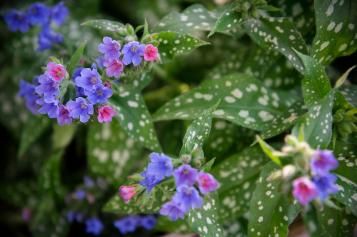
Lungwort
One of the benefits of Lungwort is its pretty foliage that comes with white or silver spots or is more heavily variegated. Flowering in Spring in a combination of small pink and purple flowers, it’s a pretty addition to a shady garden and is surprisingly underused.
As a shade-loving plant that doesn’t want direct light or heat, it’s best off in a border where shade is dominant. It’s generally not recommended for growing in pots as it likes a cooler soil for its roots. Lungwort is a good small shade-loving plant that gives a soft edge at the front of a shady border in any backyard.
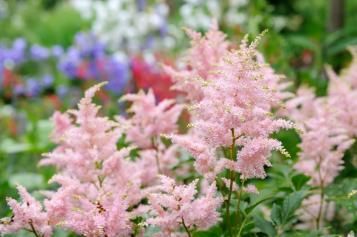
False Goat's Beard
False Goat's Beard is easily recognised with mounded fernlike, delicate foliage and tall spires of frilly and pretty foliage. Coming in a variety of colours from darkest pink through to lilac and white. Thanks to their tall flowers, they make good companion plants for Hostas alongside other shady border plants.
False Goat's Beard is another low-maintenance plant that enjoys well-drained, slightly drier soil, and whilst it can be planted in full shade, it will bloom at its best in partial shade. They also work well as a cutting flower and can be grown successfully in shady pots. Dwarf varieties work particularly well for pots.
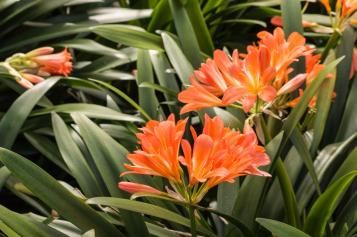
Clivia Miniata
A striking shade-loving plant that enjoys the warmer climates of Australia.
Clivia has glossy green strap leaves with a tall robust stem on which orange or red trumpet-like flowers grow. Less common bloom colours are yellows and creams. Clivia enjoys regular watering particularly when the surface is dry but like other members of the Amaryllis family, it needs only a drop of water whilst it is dormant in the winter.
As a taller shade-loving border plant, its best position would be mid-back of the border so as not to block out small shade-loving border plants at the front. Clivia enjoys being in pots as long as they are in indirect sunlight. Make sure the pot is no less than 20cm so it can grow into its space as it doesn’t like to be disturbed too regularly.
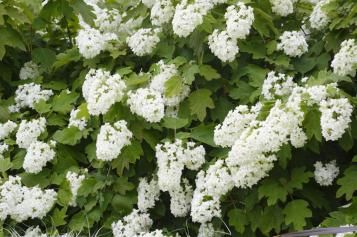
Oakleaf Hydrangea
So called Oakleaf Hydrangea due to its leaf shape which is very similar to a classic oak tree. Like other Hydrangeas, it flowers in the summer with cream flowers growing up a spire-shaped stem. In the autumn, the leaves turn a lovely red and orange.
It’s a great large shade loving plant for Australia that unlike the mophead varieties of Hydrangea is tough, cold hardy, and drought resistant. Similar to most other Hydrangeas, Oak Leaf Hydrangeas like partial shade in the afternoon and sun in the morning.
It needs well-drained soil that is slightly acidic with a feed at the start of the growing season and then part way through to ensure a longer growing season. Oakleaf Hydrangea can grow quite large, so plan for needing a decent space at the back of your border.
If you want to retain the plant size and just do a light shaping, then spring is the time to prune. But if you want to prune to the ground to keep this shade loving plant small, then prune after the flowers have finished. This type of pruning can also be done in the spring. Think carefully about when you want to prune an Oakleaf Hydrangea flower on old wood, as if you cut to the ground it is unlikely you will get flowers.
These partial shade loving plants can be grown in pots, but remember to keep them in shade ideally in the afternoon. You may want to consider the dwarf variety as its size is better suited to pots.
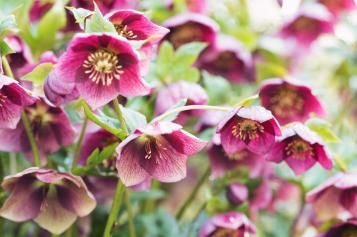
Hellebore
Hellebore, sometimes called the Winter Rose or Christmas Rose, is a semi-evergreen perennial native to Greece and Turkey so it’s well accustomed to warm weather. It does however prefer a shady border to really flourish and show off its lovely flowers that come in a range of colours from true white, pinks, dark magenta through to even a very near black.
Hellebores are low mound growing plants whose foliage dies down somewhat and then new growth appears halfway through the year. They are truly a regal-looking plant that adds colour at the start of the season. Growing equally as well in pots they provide shade with their large leaves for other like-minded woodland plants. Hellebores are best placed in the middle area of your border as they can become quite big.
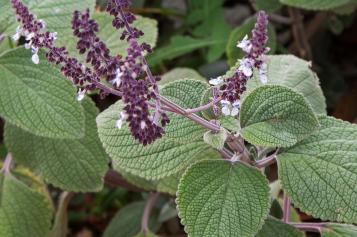
Silver Spurflower
A free flowing Australian native evergreen shrub with soft, velvety, silvery leaves that are darker in the shade, Silver Spurflower is a vigorous shrub that will need a strong prune in late winter. Originating from woodland and forests, the flowers are a stunning delicate spire filled with lilac flowers over the autumn months.
If growing in a border, the middle is best for size and height reasons. Although not suitable as a house plant, its foliage makes for a lovely cut flower arrangement. As well as being a shade loving flowering plant, they are well known as drought tolerant, so a real all-rounder!

New Zealand Rock Lily
As a native of New Zealand, it is well suited to being a good choice for an Australian shade loving border plant. The New Zealand Rock Lily is a herbaceous perennial and has been used for food and medicine as well as being of importance to Maori culture.
It has large glossy strap leaves with a robust elegant stem that holds the pretty white sprays of dancing star-shaped flowers. It is also a low maintenance and drought friendly plant, and only needs the bottom leaves tidied up, some watering during its growth period and general fertiliser in spring.
Although it will thrive in fertile soil, it can manage with most soil types as long as it’s free draining. Looking most effective planted under trees or on rockers, the New Zealand Rock Lily can also be grown in pots, but make sure they are large enough as they can grow up to 1m in either direction.
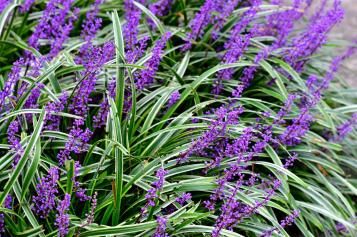
Giant Lilyturf
The Giant Lilyturf originated in Japan and is a plant that can grow in both partial shade to full shade. It’s true to say that apart from its variegated cream and green leaves, it looks similar to a Liriope, but is quite difficult to get hold of.
As a clumping modo grass with long variegated blade shaped leaves it also has white spear shaped flowers that bloom in the summer with berries following. The Giant Lilyturf doesn’t particularly need watering, only in prolonged and strong heat and can also grow on mid-range soil.
It’s generally not a fussy plant as it only needs a light prune to remove any spent foliage or flowers. It can also be grown in pots but do make sure it’s beneath trees and that the pot is large enough to happily hold it.

Coral Bells
Coral Bells are a popular shade loving perennial shrub for Australia. They come in a large variety of foliage colours from vivid lettuce light green through to the darkest purple, not to mention two tone colours. They certainly add interest to a shady border in any garden!
In general they prefer dappled or partial shade with the darker-leaved varieties being able to withstand more sun and the lighter varieties needing more shade so their leaves aren’t scorched. Growing towards the front-middle of a border, they form leafy clumps with tall thin stems that hold delicate ball like flowers. They need a good rich moist soil that is free draining to encourage their wonderful colourful foliage to be at its best.
It’s another low-maintenance shade loving plant that just needs a tidy up of dead leaves and removal of any flowers that have finished - this encourages new flowers. If you live in a colder zone, be mindful of not cutting back any dead leaves until the weather is warmer as these leaves provide protection for the new crown coming through.
Coral bells work very well in pots and containers that have the right amount of shade for their leaf colour. Just remember to check on the water levels in pots.
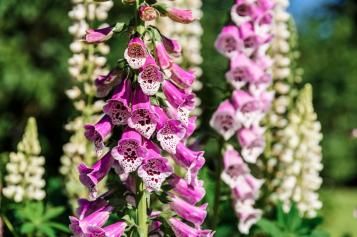
Foxglove
This is a classic shade loving plant that originates from woodlands and can be classified as a perennial, shrub or biennial. Traditionally in a bright pink, their blooms also come in white, lavender, yellow, red and purple. The biennial variety will flower in their second year, lay their seed and then die.
Foxgloves usually have one tall spire with the medium sized flowers coming off the top of the stem, but if you’d like more stems, cut off the central spike. If you want more flowers to come in following years, leave the stems on to develop seeds. To flourish, they enjoy rich moist free draining soil with no fertising needed if the soil is rich enough.
Foxgloves provide a tall and colourful display in shady borders at the back due to their height and are very pollinator friendly. They can grow in shady pots, but make sure they are big enough to hold a large plant as Foxgloves can grow up to 0.5m 1.5m tall.








